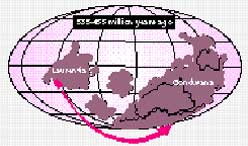A continental jigsaw
 according to a new study by William Thomas, a geologist at the University of Kentucky, us , a large chunk of the eastern foothills of the Argentine Andes was once a part of North America. About 535 million years ago, a piece roughly the combined size of Portugal and Spain broke off from what is now east Texas, then drifted across several thousand kilometres of the ocean and collided with South America some 80 million years later. Initially, it formed a mini continent called Precordillera but later, got squeezed into a strip about 1,000 km long and 100 km wide ( New Scientist , Vol 151, No 2043).
according to a new study by William Thomas, a geologist at the University of Kentucky, us , a large chunk of the eastern foothills of the Argentine Andes was once a part of North America. About 535 million years ago, a piece roughly the combined size of Portugal and Spain broke off from what is now east Texas, then drifted across several thousand kilometres of the ocean and collided with South America some 80 million years later. Initially, it formed a mini continent called Precordillera but later, got squeezed into a strip about 1,000 km long and 100 km wide ( New Scientist , Vol 151, No 2043).
Plate tectonic studies reveal that continents grow by amassing around their edges chunks of older continents or mid-ocean islands called terranes. By studying marked similarities in ancient Argentinian rocks and rocks of the same age from Texas and other parts of Laurentia, the ancient North American continent, earlier geologists had concluded that the Americas collided about half-a-billion years ago. Thomas and Ricardo Astini, an Argentinian geologist at the National University of Argentina at Cordoba, have come up with an alternative theory based on fossil findings.
The story began with the opening up of the Ourachita rift across east Texas almost 700 million years ago. Precordillera then pulled away from Texas and moved some 800 km apart. The flora and fauna gradually began to change as the continent started its long drift towards Gondwana, a supercontinent which included South America, Africa, India, Antarctica and Australia. After that, Precordillera was compressed by collisions, movements of tectonic plates and other geological disturbances and rose up high to form what is now the Argentinian Andes.
